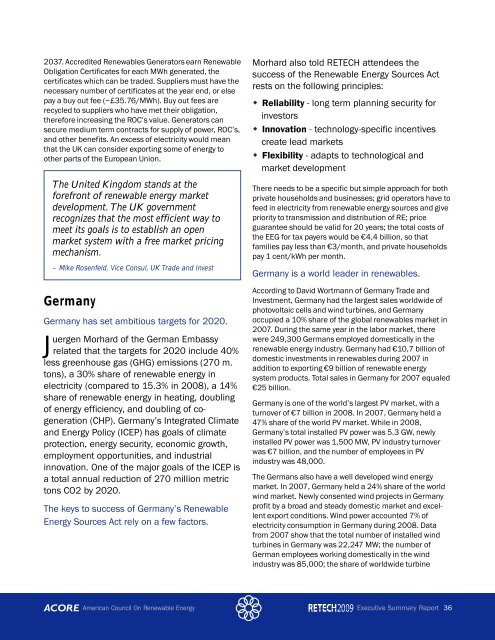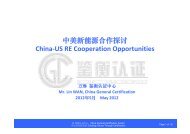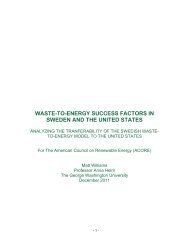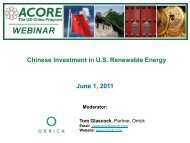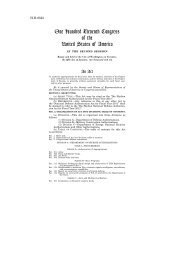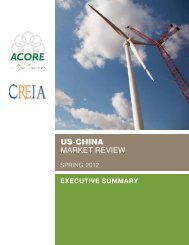2037. Accredited <strong>Renewable</strong>s Generators earn <strong>Renewable</strong>Obligation Certificates for each MWh generated, thecertificates which can be traded. Suppliers must have thenecessary number of certificates at the year end, or elsepay a buy out fee (~£35.76/MWh). Buy out fees arerecycled to suppliers who have met their obligation,therefore increasing the ROC’s value. Generators cansecure medium term contracts for supply of power, ROC’s,and other benefits. An excess of electricity would meanthat the UK can consider exporting some of energy toother parts of the European Union.The United Kingdom stands at theforefront of renewable energy marketdevelopment. The UK governmentrecognizes that the most efficient way tomeet its goals is to establish an openmarket system with a free market pricingmechanism.– Mike Rosenfeld, Vice Consul, UK Trade and InvestGermanyGermany has set ambitious targets for 2020.Juergen Morhard of the German Embassyrelated that the targets for 2020 include 40%less greenhouse gas (GHG) emissions (270 m.tons), a 30% share of renewable energy inelectricity (compared to 15.3% in 2008), a 14%share of renewable energy in heating, doublingof energy efficiency, and doubling of cogeneration(CHP). Germany’s Integrated Climateand <strong>Energy</strong> Policy (ICEP) has goals of climateprotection, energy security, economic growth,employment opportunities, and industrialinnovation. <strong>On</strong>e of the major goals of the ICEP isa total annual reduction of 270 million metrictons CO2 by 2020.The keys to success of Germany’s <strong>Renewable</strong><strong>Energy</strong> Sources Act rely on a few factors.Morhard also told RETECH attendees thesuccess of the <strong>Renewable</strong> <strong>Energy</strong> Sources Actrests on the following principles:• Reliability - long term planning security forinvestors• Innovation - technology-specific incentivescreate lead markets• Flexibility - adapts to technological andmarket developmentThere needs to be a specific but simple approach for bothprivate households and businesses; grid operators have tofeed in electricity from renewable energy sources and givepriority to transmission and distribution of RE; priceguarantee should be valid for 20 years; the total costs ofthe EEG for tax payers would be €4,4 billion, so thatfamilies pay less than €3/month, and private householdspay 1 cent/kWh per month.Germany is a world leader in renewables.According to David Wortmann of Germany Trade andInvestment, Germany had the largest sales worldwide ofphotovoltaic cells and wind turbines, and Germanyoccupied a 10% share of the global renewables market in2007. During the same year in the labor market, therewere 249,300 Germans employed domestically in therenewable energy industry. Germany had €10,7 billion ofdomestic investments in renewables during 2007 inaddition to exporting €9 billion of renewable energysystem products. Total sales in Germany for 2007 equaled€25 billion.Germany is one of the world’s largest PV market, with aturnover of €7 billion in 2008. In 2007, Germany held a47% share of the world PV market. While in 2008,Germany’s total installed PV power was 5.3 GW, newlyinstalled PV power was 1,500 MW, PV industry turnoverwas €7 billion, and the number of employees in PVindustry was 48,000.The Germans also have a well developed wind energymarket. In 2007, Germany held a 24% share of the worldwind market. Newly consented wind projects in Germanyprofit by a broad and steady domestic market and excellentexport conditions. Wind power accounted 7% ofelectricity consumption in Germany during 2008. Datafrom 2007 show that the total number of installed windturbines in Germany was 22,247 MW; the number ofGerman employees working domestically in the windindustry was 85,000; the share of worldwide turbine<strong>American</strong> <strong>Council</strong> <strong>On</strong> <strong>Renewable</strong> <strong>Energy</strong>Executive Summary Report 36
production was 37%; the domestic turnover was €5.6billion and export turnover was €7.5 billion. In Germany,26 offshore wind projects with a capacity of greater than25 GW have been approved, and another 19 projects arecurrently pending approval. There is now space forhundreds of small wind developers, which opens themarket for new and bigger players. Capacity shortages inseveral areas offer significant business opportunities.ChinaOver the next twenty years, China will need tofind an alternative to coal-fired power generationin order to meet its expanding national energyconsumption.According to Louis Schwartz of China Strategies,LLC, between 2005 and 2030, China will bespending $1.2 trillion US on electrical powerinvestments. In 2006, power generated fromcoal accounted for 69% of total energy consumptionin China; by 2050, coal-fired powerplants will account for 30% to 50% of China’senergy needs. In 2006 alone, China added anadditional 92,000 MW of coal-fired powerplants. In 2007, 11,000 MW of the worst coalfiredpower plants were closed. In 2008, another13,000 MW of outdated capacity will be closed.China is choosing renewable energy foreconomic, social, and environmental reasons.Between 2005 and 2030, China willaccount for 23 percent of the world’sinvestment in electrical power. <strong>Renewable</strong>energy will help to curb greenhouse gasemissions, increase energy security, andprovide sustainable distributed generationoptions to those 10 million Chinese whodo not have access to electrical power.– Louis Schwartz, President, China Strategies, LLCInvestments, research, and development of renewableenergy offer opportunities to alleviate degradation of theenvironment, meet growing demands for energy, implementenergy security, and enhance economic developmentin rural areas. Beijing plans to invest approximately$263 billion US through 2020 to foster the developmentof China’s renewable energy resources. Officials areprojecting that China can generate 16% of their totalenergy load from renewables by 2020. By 2020, there willbe 300,000 MW of hydropower, 30,000 MW of windpower, 30,000 MW of bio-mass, 1800 MW of solar power,300 million sq. meters coverage of solar hot waterheaters, 20 million tpy of bio-fuels and 44 billion sq.meters of methane gas.Many Chinese have little or no access to power.Schwartz reported there are more than 10 million Chinesewho do not have access to electric power and tens ofmillions more rural Chinese with only spotty access. Tocombat this lack of electrification, Beijing has specificgoals for rural power development, including strengtheningthe construction of small-scale rural hydropower plantsand power grids, local wind power, biomass and solarprojects. By 2010, Beijing plans to have in place 300,000small-scale wind turbines in rural areas of China, to have40 million households using methane gas, 50 millionsquare meters of solar-powered hot water heaters and 1million solar-powered stoves in use.China’s growing middle class has generated anunparalleled demand for energy.Between 2005 and 2030, China will account for 23percent of the world’s investment in electrical power.<strong>Renewable</strong> energy will help to curb greenhouse gasemissions, increase energy security, and provide sustainabledistributed generation options to those 10 millionChinese who do not have access to electrical power.“New” energy equated to roughly 9% of the energy mix in2008.<strong>On</strong>e of the most important aspects of China’simminent growth rests on the expansion andimprovement of its national grid system over thenext few years.China’s existing power grid, the largest power network inthe world, is the one of the biggest hindrances to furtherdevelopment. The smart grid remains an emergingconcept. However, the outlook is positive; in China’sstimulus package of $585 billion, China’s state gridcorporation will invest $170 billion in new grid construction.<strong>American</strong> <strong>Council</strong> <strong>On</strong> <strong>Renewable</strong> <strong>Energy</strong>Executive Summary Report 37
- Page 6: The highlights of WIREC 2008 includ
- Page 9 and 10: EVENT SPONSORSHosted byBadge Sponso
- Page 11 and 12: EXHIBITORS ContinuedKamatics Corp.K
- Page 13 and 14: The ARRA contains the following ite
- Page 15 and 16: “How do we organize ourselves to
- Page 17 and 18: John GeesmanFormer Commissioner, Ca
- Page 19 and 20: Cathy ZoiCEO, Alliance for Climate
- Page 21 and 22: John CavalierManaging Partner, Huds
- Page 23 and 24: BiofuelsChristopher Groobey, Partne
- Page 25 and 26: Patrick Cloney, Executive Director,
- Page 27 and 28: Gal Luft, Executive Director, Insti
- Page 29 and 30: Daniel Kammen, Class of 1935 Distin
- Page 31 and 32: Biomass, Biofuels, and Advanced Veh
- Page 33 and 34: Critical development opportunities
- Page 35 and 36: ConclusionsSpeakers at RETECH 2009
- Page 37 and 38: Geothermal PowerOverviewThe United
- Page 39 and 40: Green Buildings and CommunitiesOver
- Page 41 and 42: Green construction and renovation s
- Page 43 and 44: Session ReferencesGreen Schools Bre
- Page 45 and 46: 1. The local electric power market
- Page 47: International Renewable Energy Indu
- Page 51 and 52: There have been a number of incenti
- Page 53 and 54: educes mortality and improves gende
- Page 55 and 56: D7 - ChinaJing Su, Director of US-C
- Page 57 and 58: past, uncertain legislative environ
- Page 59 and 60: marketplace, accelerating and deepe
- Page 61 and 62: • Complexity and operating costs
- Page 63 and 64: C6 - Environmental and Carbon Finan
- Page 65 and 66: The technology debate: thin film ve
- Page 67 and 68: FITs have grown in popularity over
- Page 69 and 70: Haroula Reitz, Global Manager of Sc
- Page 71 and 72: Currently, planning is geographical
- Page 73 and 74: Federal policy should allow for a c
- Page 75 and 76: Wind: Markets, Technologies, and Po
- Page 77 and 78: Regional FactorsBesides federal pol


